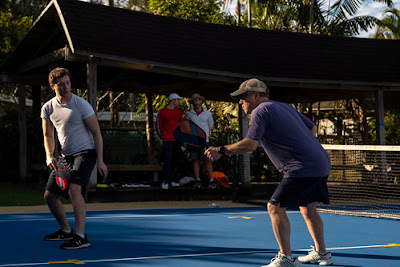How to Play
Pickleball: A Detailed Guide
If you're looking for basic information from a novice on Pickleball, then you have come to the right place!
In recent years, pickleball has emerged as a veritable
pick-up game for older players. The fast-paced, exhilarating experience offers
an invigorating workout while also fostering social interaction between friends
and family. It's no surprise that this sport is gaining popularity among those
aged 50+!
Pickleball originated in the 1930s as a novel indoor
sport that utilized two rubber disks - one red, one white - which were thrown
at each other. Its popularity soared with the introduction of televised matches
featuring the iconic Bobby Riggs and Billie Jean King in the 1960s; even today
it continues to blossom into an engaging activity enjoyed by millions around
the globe.
With its simple rules yet addictive nature, pickleball
is ideal for anyone looking for an exhilarating challenge. Let's explore this
exciting new sport!
1. Pickleball Rules Are Simple: Who's on
the Court
Pickleball is a fast-paced game that can be enjoyed by
players of any skill level. From the seasoned pro to youngsters just
discovering the sport, everyone is welcome at the courtside!
Players are classified according to their experience
levels:
Novice (1st-3rd Level Players)
Experienced (4th-6th Level Players)
Advanced (7th-9th Level Players)
Elite (10th Level and Up)
The play classification system was created by the
United States Pickleball Association in 2004, which determines when players
enter match play. It's based on how much experience one has with standard
pickleball rules; novice players up until the 5th level are required to abide
by these guidelines before progressing forward into higher leagues.
What They Can Do and What They're Not
Allowed to Do
Pickleball is a terrific sport for both experienced and
novice players alike. It's an extremely accessible game that anyone can pick up
quickly, even if they've never played before or have limited contact sports
experience.
That said, there are some rules to which you must adhere
in order to fully enjoy Pickleball. Here are some of the most significant aspects you should consider:
You cannot hit any part of a player's body with a
racket. Even if your opponent accidentally hits themselves on the arm due to an
errant shot - even if it doesn't hurt them at all - this will still result in
penalties!
Don't forget about the no-hit rule when playing
Pickleball. If one of your shots comes off from outside the strike zone and
lands in the center, then judge wisely before making a call on which team is
allowed to play again!
2. How to Start Playing Pickleball
Serve the ball: The serving team starts the game by serving the ball underhand, from behind the baseline, diagonally across the court to the opposing team's service court.
Return the serve:
The receiving team must allow the ball to bounce once before returning it back
over the net. After the ball has bounced, the receiving team can hit the ball
back to the serving team's side of the court.
Keep playing until a point
is scored: The ball must stay in play, and each team must hit the
ball over the net and into the opponent's court until a point is scored. A
point is awarded when the opposing team fails to return the ball, hits the ball
out of bounds, or commits a fault, such as touching the net or hitting the ball
out of order.
Rotate serve:
The serving team switches sides of the court each time they win a point, and
the server switches sides of the court each time their team loses a point. If
playing doubles, the server alternates between teammates.
Play until a team reaches 11 points: The game is played until one team reaches 11 points (and wins by a margin of two points) or a predetermined number of points agreed upon by the players before the start of the game.
No prior experience is necessary; anyone who is eager
to learn will find plenty of options.
3. To Play Offensively or Defensively? How
About Both!
Pickleball is a fast-paced, fun sport that lends itself equally to both offensive and defensive play styles. Nevertheless, in order for a team to be successful at all levels of play, players must master their strengths and capitalize on those areas where they excel. Hitting the ball with great force and accuracy requires agility, speed and quickness as well as focused concentration.
4. Where to Play Pickleball
Are you seeking an outlet for your leisurely pursuits?
Don't despair, there are a plethora of options for you to choose from.
Perhaps a well-known court such as those located at your nearest community center or recreation center will suffice; however, if you wish to venture further afield in search of more possibilities - don't worry!
For starters, there's always the option of creating
your very own pickleball court in your backyard. If that feels like too much of
an undertaking, why not visit one of the numerous local parks and check out
their existing setups?
5. Equipment Needed to Play Pickleball
To play pickleball, you will need the following
equipment:
Pickleball Paddle: A
pickleball paddle is a paddle-shaped racket used to hit the pickleball. Paddles
can be made of wood, graphite, or composite materials.
Pickleball Ball:
Pickleballs are plastic balls with holes, similar to a wiffle ball. They come
in different colors, but the most common are yellow for outdoor play and white
for indoor play.
Pickleball Court: A
pickleball court is similar in size to a badminton court, measuring 20 feet
wide by 44 feet long. The court can be marked on any hard surface, such as a
tennis court, basketball court, or even a driveway.
Net: A pickleball net is 36
inches high at the ends and 34 inches high in the middle. The net should be
suspended over the center of the court and be taut.
Comfortable Shoes: It's
important to wear comfortable shoes that provide good support and have
non-marking soles.
Appropriate Clothing: Wear
clothing that allows for easy movement and is comfortable for physical
activity.
That's all you need to get started playing pickleball. As you become more advanced, you may want to invest in additional equipment such as balls with different characteristics or specialized paddles.
While there are no official regulations for the size and shape of a pickleball paddle, there are some general guidelines that are followed by most manufacturers to ensure that paddles are suitable for pickleball play.
According to the USA Pickleball Association (USAPA), the governing body for the sport in the United States, a pickleball paddle must be a solid, flat-surfaced paddle with no strings. The paddle can be any size, but it must not exceed 24 inches in length and 8 inches in width. The total length and width of the paddle, including the handle, cannot exceed 24 inches and the thickness cannot exceed 1 inch.
Also note that the paddle must not contain any materials that would give a player an unfair advantage, such as lead, sand, tackiness products or other weighting agents. The paddle must also be designed to provide a fair and consistent bounce when the ball is struck.
While there are some variations in paddle design and materials used, most pickleball paddles sold commercially today adhere to these general guidelines and are suitable for play in official pickleball competitions.
It's important to check with your local pickleball club or organization to ensure that the paddle you plan to use is approved for play in your area.
My pickleball racket is average but great for me. I like to think it boasts a unique shape that provides excellent balance and responsiveness - characteristics which are vital for any player looking to achieve proficiency.
Can Pickleball be Played as Singles?
Yes, pickleball can be played as singles. While pickleball is traditionally played as a doubles game, where two players are on each side of the court, it is also possible to play it as a singles game, where there is only one player on each side of the court.
The rules of pickleball do not change when playing singles, but the court size may be adjusted to make it smaller, depending on the number of players. The singles court is 20 feet wide and 44 feet long, which is narrower than the doubles court.
Pickleball Tips
Focus on your footwork:
Good footwork is key to being able to get in position to hit the ball. Keep
your feet moving and position yourself well to make the best shots.
Aim for the
"kitchen": The "kitchen" is the non-volley
zone located on both sides of the net. Hitting the ball into the kitchen can be
an effective way to win points, as opponents are not allowed to hit the ball
out of the air while inside this area.
Mix up your shots:
Varying the speed, direction, and spin of your shots can help keep your opponents
off-balance and make it harder for them to return the ball.
Communicate with your partner: If playing doubles, it's important to communicate with your partner to avoid confusion and ensure that you are covering the court effectively.
Keep your paddle up: Keeping your paddle up and ready to hit the ball can help you react quickly and make the most of your shots.
Watch your opponent's paddle: By paying attention to your opponent's paddle, you can anticipate where they might hit the ball and be better prepared to make a return.
Practice your serve: A
good serve can give you an advantage right from the start of the game. Practice
your serve to develop consistency and accuracy.
Stay patient: Don't rush your shots or try to force a winner. Be patient and wait for the right opportunity to make your move.
Final Thoughts
Pickleball is an exciting and challenging game, and with the right knowledge and practice, you can become a skilled player in no time. Learning the basics will give you a strong foundation to build on as you explore more advanced strategies. With its fast-paced action and social atmosphere, it’s easy to see why pickleball has grown so rapidly in popularity. So grab some friends, hit the courts, and have fun!
The Pickleball Association of America has certified more than 200 Pickleball courts within accredited club locations throughout the country. To locate one close to you and to determine if your facility meets their criteria, please visit their website for additional information.
Hope you found this article helpful and enjoyable. Thank you for reading!
👉This post may contain affiliate links. As an Amazon Associate and member of other affiliate programs, we earn from qualifying purchases.












Comments
Post a Comment